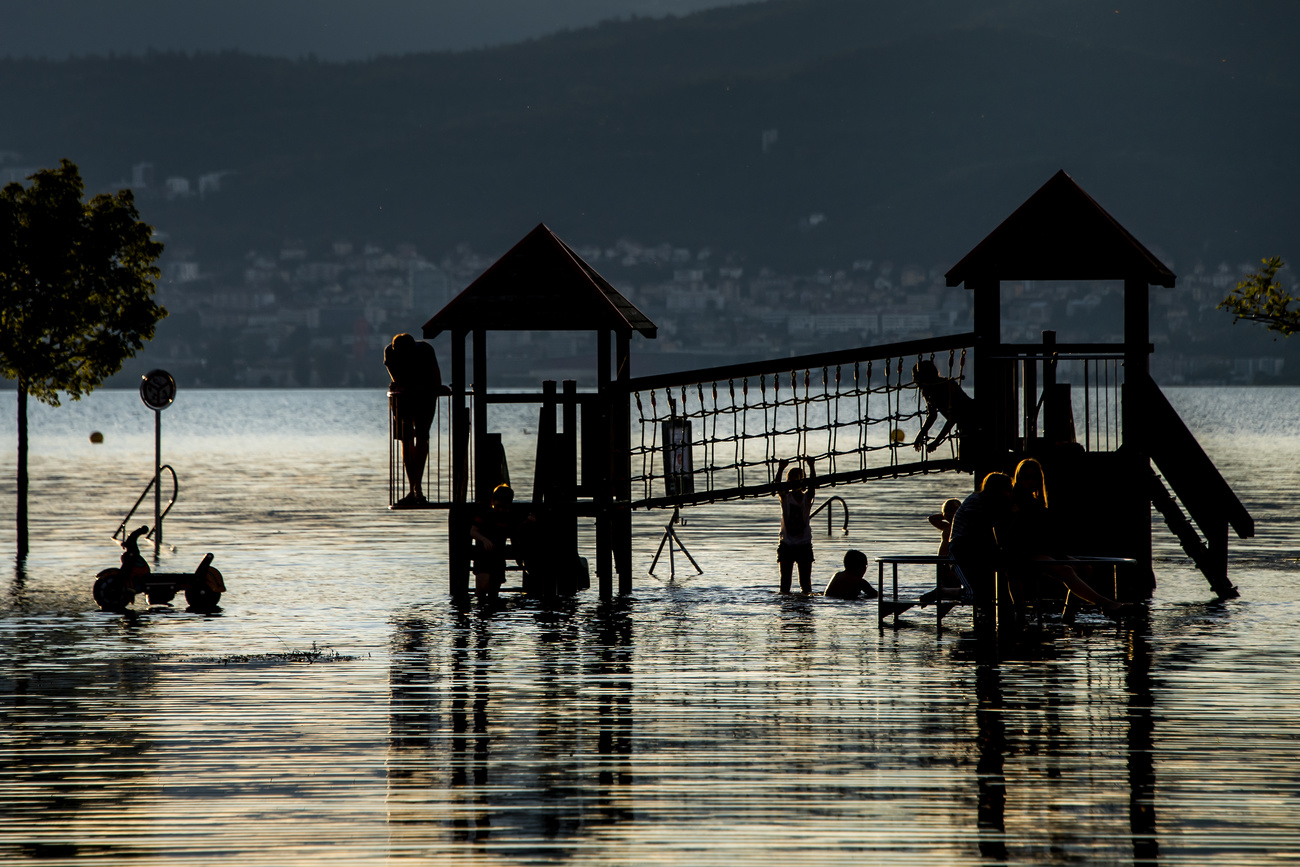
Is Switzerland’s natural disaster insurance a model for the world?

Twenty years after the “flood of the century”, the Swiss approach to hazard insurance, based on solidarity, could inspire other countries dealing with increasingly frequent disasters.
“The River Aare is now flowing through the alleys of this old part of the city and the water has reached the first floor of many houses.” So began a Swissinfo report from the Matte district in Bern’s Old Town after torrential rains hit central and eastern Switzerland beginning on August 21, 2005.
The flood was one of the worst natural disasters in modern Swiss history. Six people died and property damage totalled about CHF3 billion ($3.7 billion), making it the largest insurance payout in Switzerland since 1970.
“Climate change is making it increasingly difficult to insure the risks posed by extreme events.”
Stefano Ceolotto, researcher at the Euro-Mediterranean Center on Climate Change.
Twenty years later, the banks of the Aare have been partly reinforced, and the Matte district has regained its old charm. The repairs to private property were largely covered by Switzerland’s unique natural disaster insurance programme, which paid out CHF2.3 billion.
The risk of another major flood, in Bern as in many other regions of Switzerland, remains. Floods, landslides, hail, forest fires and other extreme events are becoming more intense and more frequent all over the world owing to climate change. They are also becoming more expensive.
>> Due to increased flood risk Swiss cities are implementing innovative methods to mitigate risks:

More
Urban flooding slowly becomes a priority issue for Switzerland
In the first half of 2025, global insured losses from natural disasters reached $80 billion (CHF64 billion). That’s almost double the average for the same time span in the previous ten years, according to preliminary estimates by reinsurance company Swiss Re.

“Climate change is making it increasingly difficult to insure the risks posed by extreme events as they become more damaging, more frequent and more variable,” saidExternal link Stefano Ceolotto, researcher at the Euro-Mediterranean Center on Climate Change.
Some insurers are reacting by increasing premiums, limiting coverage or refusing to renew policies in high-risk locations. In the United States, for example, home insurance rates grew by nearly 34% between 2018 and 2023External link. Private companies in California are refusing to offer new policies in regions they consider at high risk from wildfires.
But the Swiss insurance system for natural disasters appears capable of absorbing even the most devastating events, as was the case after the landslide that buried the village of Blatten this year. Under the Swiss programme, all places remain insurable, even in areas at high risk of floods, landslides or avalanches, according to insurance experts recently interviewed by Swiss public broadcaster, RTSExternal link. Insurance companies also take a proactive role in preventing damage, leading to lower costs and faster recovery.
It is a unique model that could inspire other countries as they struggle to deal with costly climate disasters.
Solidarity among the insured
The special feature of the Swiss system is the principle of double solidarity: all insured people and all insurance companies assume the risk together.
In most Swiss cantons, homeowners are required to take out insurance with a cantonal insurance institute. These are public institutions responsible for insuring buildings against fire risk and damage caused by natural elements. Rates are set by law and are based on the value of a property. They do not increase if a building is in a danger zone, such as near waterways that are prone to flooding.
The compulsory insurance covers a range of natural events, including floods, storms and hail (but not earthquakes).
Coverage rates are high even in cantons with no cantonal insurance obligation, such as Valais, where the market is managed by private companies. Also in this case all homeowners pay the same premium. The rate is set by the Swiss Financial Market Supervisory Authority (FINMA), an independent regulatory body. Today more than 95% of the housing stock in Switzerland is covered against natural disasters.
This coverage is vital. More than half of the buildings in Switzerland are at risk of flooding, according to the Swiss Insurance Association (SIA). The Swiss population is among the most vulnerable in Europe.
Solidarity among insurers
In the cantons with compulsory public insurance, damages are covered by the public institutions. In cantons with private coverage, costs are shared between insurers, providing an additional level of solidarity that makes the Swiss system effective.
The 12 insurers that cover over 90% of the natural perils market in the privately covered areas all pay into a pool established by the SIA, called the ES poolExternal link. This voluntary association began in 1936 as a way to optimise risk diversification and risk exposure.
After a catastrophe, the insurers in the ES pool jointly bear 80% of the costs in proportion to their market share. The remaining 20% is borne by the insurer that provided the coverage. The pool is one reason why private insurers continue to offer policies in high-risk areas, even when coverage is not required by law.
“This system ensures affordable premiums and sustainability of natural hazard coverage, even in areas where the risk is above average,” explains Eduard Held, director of the ES pool.
Between 1970 and 2023, insurance companies in the pool paid about CHF7 billion in claims. In the 2005 flood, claims to private insurers amounted to more than CHF1 billion with the rest paid by public institutions.

Low insurance gap in Switzerland
In many countries, such as Italy, Japan and the United States, insurance against natural hazards is optional. It is often operated by private companies and is not included in other types of policies.
In addition, the insurers do not have the payment pool that Swiss companies have. Without this solidarity among insurers, individual companies must take on the entire risk in hazard-prone areas – something many companies are not willing to do.
This contributes to an increase in the so-called insurance protection gap: the share of losses not covered by a policy. A big gap makes it difficult for an area, and an economy, to recover after a disaster.
The insurance gap for natural disasters in Switzerland was 26% in 2024, according to the most recent data from Swiss Re, meaning 26% of damage is not covered by insurance. The global average is 43%.
Learning from the Swiss insurance model
Insurance companies want customers to pay premiums proportional to their risk, Eugenia Cacciatori, an associate professor at Bayes Business School in London, told The GuardianExternal link. “But that creates problems, because those who are at very high risks tend to have trouble getting the insurance they need.”
The model in place in Switzerland could be an alternative, Cacciatori says. Because insurers cannot increase premiums according to risk, they instead invest in reducing potential losses. “[Insurance companies in Switzerland] are heavily involved in discussions of building standards, in which insurers in other countries are only beginning to be involved.”
Cacciatori says replicating the Swiss approach in nations with established and highly competitive insurance systems is difficult. However, she points out that some aspects could be taken on board, such as the sharing of expertise among insurers and the incentive to jointly promote prevention and risk reduction.
“The best protection against damage is prevention.”
Dominic Ramel, Mobiliare
“The Swiss system clearly stands out as one of the most efficient in Europe,” says Stefano Ceolotto.
He finds the most admirable aspect to be the collaboration between the insurance sector and local and national governments, for example in land-use planning and the drafting of risk maps. “This involvement of the insurance sector beyond merely offering coverage is what other countries should strive to replicate and encourage.”
The best protection is prevention
The 2005 flood was a turning point for the Swiss insurance industry, says Dominic Ramel, spokesperson for the oldest Swiss private insurer, Mobiliar. “We’ve been investing heavily in prevention ever since.”
Cooperation between cantons has also increased since 2005, “for example through safety days and joint exercises”, according to the SIA. Hazard maps have been updated, and new risk assessment techniques have been used for the most exposed locations.
In Switzerland, the public and private sectors together invest about CHF3 billion a year in preventive measures against natural hazards. Today, thanks to those measures and new research, the damage caused by the 2005 flood would be a third lower, according to SIA.
“The best protection against damage is prevention,” says Dominic Ramel.
>> Flood protection measures are expensive, but their economic benefits far outweigh reconstruction costs:

More
Switzerland spends big on flood protection – but is it enough?
Edited by Gabe Bullard/vdv/ts

In compliance with the JTI standards
More: SWI swissinfo.ch certified by the Journalism Trust Initiative



























You can find an overview of ongoing debates with our journalists here . Please join us!
If you want to start a conversation about a topic raised in this article or want to report factual errors, email us at english@swissinfo.ch.